
Jeffery C.The implementation of Icon and Unicon.2004
.pdf145
11.3 Garbage Collection
Allocation is simple, but garbage collection is not. The primary purpose of garbage collection is to reclaim the space occupied by "dead" objects that are not needed for subsequent program execution, so that this space can be reallocated. This means different things in different regions. In the static region, it means freeing dead coexpression blocks. In the string and block regions, it involves moving the space for dead objects from the allocated portion of the region to the free portion. This is considerably more complicated than adding a pointer to a free list. Since all free space must be in a single block in these regions, "live" objects must be moved to fill in the holes left by dead ones. This is done by compacting the allocated portion of these regions, relocating live objects toward the beginning of these regions and squeezing out dead objects. In turn, pointers to live objects have to be adjusted to correspond to their new locations. There are two phases in garbage collection:
●Location of live objects and all the pointers to them.
●Compaction of live objects and adjustment of the pointers to them.
"Garbage collection" is somewhat of a misnomer, since the process is oriented toward saving "nongarbage" objects; garbage disappears as a byproduct of this operation.
11.3.1 The Basis
The challenging problem for garbage collection is the location of objects that have to be saved, as well as all pointers to them. An object is dead, by definition, if it cannot be accessed by any future sourcelanguage computation. Conversely, by definition, an object is live if it can be accessed. Consequently, the important issue is the possibility of computational access. For example, it is always possible to access the value of &subject, and this value must be preserved by garbage collection. On the other hand, in
a := [1,2,3] a := list(10)
after the execution of the second assignment, the first list assigned to a is inaccessible and can be collected.
It is essential to save any object that may be accessed, but there is no way, in general, to know if a specific object will be accessed. For example, a computational path may depend on factors that are external to the program, such as the value of data that is read from a file. It does comparatively little harm to save an object that might be accessed but, in fact, never is. Some storage is wasted, but it is likely to be reclaimed during a subsequent collection. It is a serious error, on the other hand, to discard an object that subsequently is accessed. In the first place, the former value of such an object usually is overwritten and hence is "garbage" if it is subsequently accessed. Furthermore, accessing such an object may overwrite another accessible object that now occupies the space for the former one. The effects may range from incorrect computational results to addressing violations. The sources of such errors also are hard to locate, since they may not be manifested until considerably later during execution and in a context that is unrelated to the real cause of the problem. Consequently, it is important to be conservative and to err, if at all, on the side of saving objects whose subsequent accessibility is questionable. Note that it is not only necessary to locate all accessible objects, but it is also necessary to locate all pointers to objects that may be relocated.
146
The location phase starts with a basis that consists of descriptors that point to objects that may be accessible and from which other objects may be accessed. For example, &subject is in the basis. The precise content of the basis is partly a consequence of properties of the Icon language and partly a consequence of the way the runtime system is implemented. The basis consists of the following descriptors:
•
•
•
•
•
•
•
&main (coexpression block for the initial call of main) current coexpression block
values of global identifiers values of static identifiers &subject
saved values of map arguments tended descriptors
The tended descriptors provide temporary storage for a runtime support routine in which a garbage collection may occur. See Sec. 12.2.2.
Not all objects that have to be saved are pointed to directly by the basis. The value of a local identifier on the interpreter stack may point to a listheader block that in turn points to a listelement block that contains elements pointing to strings and other blocks. Pointer chains also can be circular.
11.3.2 The Location Phase
For historical reasons, the location phase is sometimes called marking. This term refers to the common practice of setting an identifying bit in objects that have been located. Not all such processes actually change the objects that are located. The way that this is done in Icon depends on the region in which an object is located.
During the location phase, every descriptor in the basis is examined. A descriptor is of interest only if it is a qualifier or if its vword contains a pointer (that is, if its dword contains a p flag). For a pointer dp to a descriptor, the following checks are performed:
if (Qual(*dp)) postqual(dp);
else if (Pointer(*dp)) markblock(dp);
where the macro Pointer(d) tests the dword of d for a p flag.
Strings. The routine postqual first checks that the vword of the qualifier points to a string in the allocated string region, since strings in other parts of memory are not of interest during garbage collection. If the string is in the allocated string region. a pointer to the qualifier is placed in an array:
postqual(dp) struct descrip *dp;
{
if (StrLoc(*dp) >= strbase && StrLoc(*dp) < strend) *qualfree++ = dp;
}

147
The array quallist is empty when garbage collection begins. Its size is checked before a pointer is added to it, and more space is obtained if it is needed although the code for doing that is not shown here. See Sec. 11.3.6.
The pointers that accumulate in quallist during the marking phase provide the information necessary to determine the portion of the allocated string region that is in use. In addition, these pointers point to all the qualifiers whose vword must be adjusted when the strings they point to are moved during the compaction of string region. See Sec. 11.3.3.
Blocks. The location phase for blocks is more complicated than that for strings, since blocks can contain descriptors that point to strings as well as to other blocks. The objects that these descriptors point to must be processed also.
Unlike strings, in which a separate array is used to keep track of qualifier that have been located, no extra space is needed to keep track of descriptors that point to blocks. Instead, descriptors and the titles of the blocks they point to are modified temporarily.
The title of any block located in the allocated block region is changed to point to a back chain that contains all the descriptors that point to that block. The descriptors are linked through their vwords.
The following example illustrates the process. Suppose there is a record declaration
record term(value, code, count)
and that the following expressions are evaluated:
x := term("chair", "noun",4) y := x
The values of x, y, and the block they point to are related as follows:
Suppose that the descriptor containing the value of x is processed during the location phase before the descriptor containing the value of y. This descriptor is identified as pointing to a block in the allocated block region by virtue of the p flag in its dword and an address range check on the value of its vword. The back chain is established by setting the title word of the block to point to the descriptor and setting the vword of the descriptor to hold the previous conter the title word. The result is
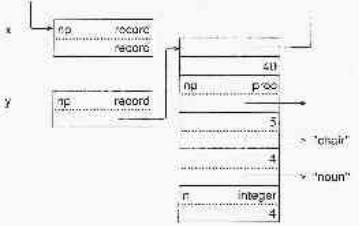
148
The title word of the block now points to the descriptor that previously pointed to the block. This change is reversible, and prior to the completion of the garbage collection process the previous relationship is restored. A crucial but somewhat subtle aspect of the change is that it is now possible to tell that the block has been marked. The numerical magnitude of the value of its title word is greater than that of any type code, since all descriptors in the runtime system are at memory locations whose addresses are larger than the largest type code.
The descriptors in the record block now are processed in the same way as descriptors in the basis. In order to do this, it is necessary to know where descriptors are located in the block. Since blocks in the allocated block region are organized so that all descriptors follow all nondescriptor data, it is only necessary to know where the first descriptor is and how large the block is. These values are determined using two arrays that have entries for each type code.
The first array, bsizes, provides the information that is needed to determine block sizes. There are three kinds of entries. An entry of 1 indicates a type for which there is no block or for which the blocks are not in the allocated block region. Examples are T_Null and T_Coexpr. An entry of 0 indicates that the size of the block follows the block title. This is the case for records. Any other entry is the actual size of the block in bytes. For example, the entry in bsizes for T_List is 24 on a 32bit computer.
The second array, firstd, is used to determine the byte offset of the first descriptor in the block. As with bsizes, a value of 1 indicates a type for which there are no associated blocks in the allocated block region. A value of 0 indicates that there are no descriptors in the block. Examples are T_Cset and T_Real. For T_Record, the entry is 8 for 32bit computers, indicating that the first descriptor is at an offset of 8 bytes (2 words) from the beginning of the block. See Sec. 4.2.
For the previous example, after the descriptors in the record block are processed, the location phase continues. When the descriptor that contains the value of y is processed, it is added to the back chain by again exchanging the contents of its vword with the contents of the title of the block. As a result, the title of the block points to the descriptor for the value of y and its vword points to the descriptor for the value of x:
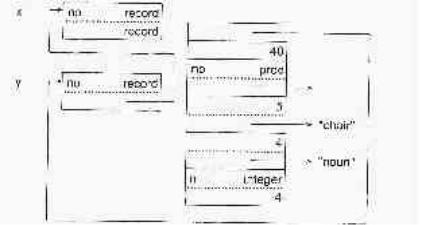
149
Since the title of the block that y points to is marked, the descriptors in it are not processed. This prevents descriptors from being processed twice and also prevents the marking phase from looping in case there are pointer loops among blocks.
If a variable descriptor is encountered when processing descriptors whose dwords contain p flags, the value the variable points to belongs to one of the following categories:
●trappedvariable block
●global or static identifier
●argument or local identifier
●descriptor in a structure
A trapped variable, indicated by a t flag in its vword, points to a block and is processed like any other descriptor that points to a block. The values of global and static identifiers are in the basis and are processed separately. The values of arguments and local identifiers are on an interpreter stack and are processed when its coexpression block is processed. A variable descriptor that points to a descriptor in a structure points within a block, not to the title of a block. This is the only case in which the offset, which is contained in the leastsignificant portion of the dword of a nontrappedvariable descriptor, is nonzero. Consequently, this offset is used to distinguish such variables from those in the second and third categories.
Continuing the previous example, suppose that a garbage collection is triggered by evaluation of the expression
x.count := read()
At the beginning of garbage collection, there is a variable descriptor for the field reference that points to the record block in addition to the descriptors for the values of x and y. If the values of x and y are processed first as described previously, the situation when the variable descriptor is encountered is
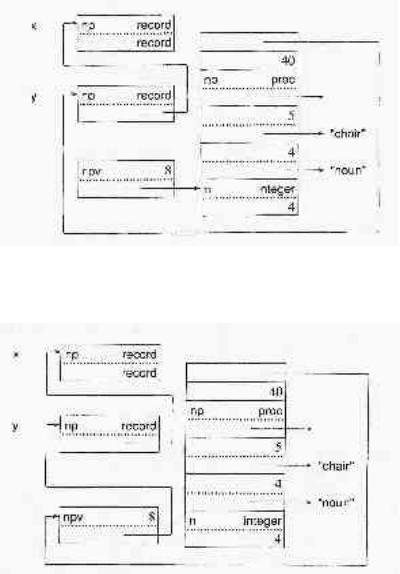
150
Note that the offset in the dword of the variable descriptor is in words, not bytes. The offset, converted to bytes, is added to the vword in the variable descriptor, and this descriptor is linked into the back chain.
When the location phase is complete, the title of each block in the allocated block region that must be saved points to a chain of all the descriptors that originally pointed to it. This provides the necessary information to adjust the vwords of these descriptors to account for the relocation of the block during the compaction phase. See Sec. 11.3.3.
If a descriptor that points to a coexpression block is encountered during the location phase, the title of the coexpression block is marked and the descriptors in the co expression block are processed in a fashion similar to that for blocks in the allocated block region. Since coexpression blocks are never moved, it is not necessary to keep track of descriptors that point to them. To mark the title, it is sufficient to change it to a value that is larger than any type code.
The activator of the coexpression (if any) is processed like any other coexpression block. Similarly, the refresh block that is pointed to from the coexpression block must be processed like any other block. The rest of the descriptors associated with a coexpression are in its interpreter stack.
151
Here the situation is more complicated than it is with blocks in the allocated block region, since interpreter stacks contain frame markers in addition to descriptors. Despite this, all the descriptors, and only the descriptors, on an interpreter stack must be processed.
Interpreter stacks are processed by the routine sweep, which starts at sp for the stack and works toward the stack base. Descriptors are processed until the next frame marker is encountered, at which point, depending on the type of the frame, the marker is skipped and new frame pointers are set up from it.
The routine for marking blocks is
markblock(dp) struct descrip *dp;
{
register struct descrip *dp1; register char *endblock, *block; static word type, fdesc, off;
/*
* Get the block to which dp points. */
block = (char *)BlkLoc(*dp);
if (block >= blkbase && block < blkfree) { /* check range */ if (Var(*dp) && !Tvar(*dp)) {
/*
*The descriptor is a variable; point block to the head
*of the block containing the descriptor to which dp
*points.
*/
off = Offset(*dp); if (off == 0)
return; else
block = (char *)«word *)block -off);
}
type = BlkType(block);
if ((uword)type <= MaxType) { /*
*The type is valid, which indicates that this block
*has not been marked. Point endblock to the byte past
*the end of the block.
*/
endblock = block + BlkSize(block);
}
/*
*Add dp to the back chain for the block and point the
*block (via the type field) to dp.
*/
BlkLoc(*dp) = (union block *)type; BlkType(block) = (word)dp;
if (((unsigned)type <= MaxType) && ((fdesc = firstd[type])
>0))
/*
*The block has not been marked, and it does contain
*descriptors. Mark each descriptor.
*/
for (dp1 = (struct descrip *)(block + fdesc);
152
(char *) dp1 < endblock; dp1++) { if (Qual(*dp1))
postqual(dp1 ); else if (Pointer(*dp1»)
markblock(dp1 );
}
}
else if (dp->dword == D_Coexpr && (unsigned)BlkType(block) <= MaxType) {
/*
*dp points to a co-expression block that has not been
*marked. Point the block to dp. Sweep the interpreter
*stack in the block. Then mark the block for the
*activating co-expression and the refresh block.
*/
BlkType(block) = (word)dp; sweep((struct b_coexpr *)block);
markblock(&((struct b_coexpr *)block)->activator); markblock(&((struct b_coexpr *)block)->freshblk);
}
}
The macro BlkType(cp) produces the type code of the block pointed to by cp. The macro BlkSize(cp) uses the array bsizes to determine the size of the block pointed to by cp.
11.3.3 Pointer Adjustment and Compaction
Strings. When the location phase is complete, quallist contains a list pointers to all the qualifiers whose vwords point to the allocated string region. For example, suppose that the allocated string region at the beginning of a garbage collection is
...Necessity is the mother of strange bedfellows...
^ ^ ^
strbase +400 strfree
Suppose also that the following qualifiers reference the allocated string region:
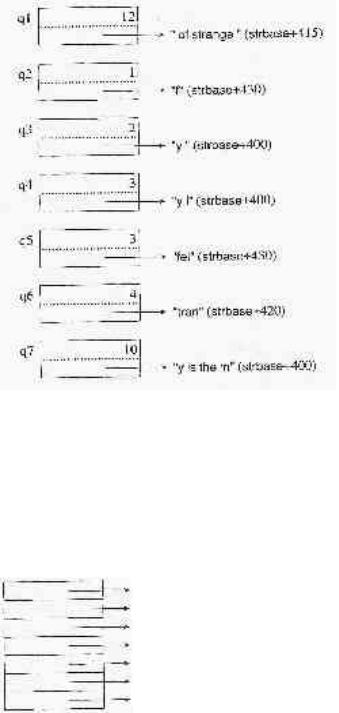
153
The pointers to the allocated string region are
...Necessity is the mother of strange bedfellows ...
^ |
^ |
^ |
^ |
^ |
^ |
strbase +400 |
+415 +420 |
+430 |
strfree |
||
Note that the qualifiers point to overlapping strings.
After the location phase, quallist might contain the following pointers:
The order of the pointers in quallist depends on the order in which the qualifiers are processed: there is no necessary relationship between the order of the pointers in quallist and the order of the pointers to the allocated string region.
At the beginning of the pointeradjustment phase of garbage collection, the array quallist is sorted in nondecreasing order by the vwords in qualifiers that are pointed to from quallist. This allows the pointers to the allocated string region to be processed in non decreasing order so that the portions of the allocated string region that must be saved and compacted can be determined.
Continuing the previous example, quallist becomes
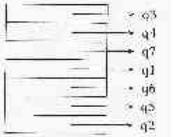
154
The vwords of the qualifiers in the order of the pointers in qual/ist now are
strbase+400
strbase+400
strbase+400
strbase+415
strbase+420
strbase+430
strbase+430
Since qualifiers may reference overlapping strings, care must be taken to identify contiguous "clumps" of characters that may be shared by qualifiers. The pointers in quallist are processed in order. Three pointers in the string region are maintained: dest, the next free destination for a clump of characters to be saved; source, the start of the next clump; and cend, the end character in the current clump.
When a qualifier that is pointed to from quallist is processed, the first question is whether its vword addresses a character that is beyond the end of the current clump (since v words are processed in numerical order, the address is either in the current clump or beyond the end of it). If it is in the current clump, cend is updated, provided the last character of the current qualifier is beyond cend. If it is not in the current clump, the clump is moved from source to dest. In either case, the vword of the current qualifier is adjusted (dest source is added to it).
In the previous example, the allocated string region after collection is Y is the m of strange fel
^ ^
strbase strfree
and the seven qualifiers that point to it are
